Rarely does anyone get the chance to taste horizontally across a vintage with more than a quarter of a century’s age, but last night Stephen Browett hosted a dinner attended by a special guest who was born in 1989, so that is exactly what we did. Luckily for me, 1989 is also my vintage, so I couldn’t have been more eager to taste through the line-up. Everything was served blind and the theme was initially kept a secret, but it soon became obvious as we tasted the first two wines, a pair of whites:
Riesling Rangen de Thann, Clos St Urbain, Zind-Humbrecht 1989
This was a medium lemony-gold colour in the glass with a rich, broad and creamy nose with touches of honey and petrol, a clean line of apples and nettles, dried flowers, and lemon rind. The palate was dry, but with notes of honeyed fruit and citrus peel. Layers of acacia, baked apple, and even lychee are tamed by a savoury minerality on the finish. The acid is crisp and lifts the flavour profile which is mature but still long. A superb showing of mature Alsatian Riesling.
Maximer Grunhauser Herrenberg Spatlese, Von Schubert 1989
A deeper gold on the nose, with a classic German Riesling aroma. Petrol, lime, honey and peach on the nose, very enticing. The palate is lightly sweet but cleansed by high acidity, notes of honeyed peaches and candied citrus peel giving way to waves of fresh lime, light petrol and some earthy undertones. The finish is very lightly sweet but carried by the power of fruit and crisp acid. In a very good place now but this will likely continue to develop well as the sweetness moves into more petrol, earth and savoury spices.
This was a great pair of white wines and was testimony to the ageing capabilities of Riesling where many other white grapes would be showing signs of tiring and others well past their best. The wine trade often praises the qualities and value of Riesling to little avail, but I will bang the drum once more. You won’t find a better quality-price ratio often in the wine world than these styles of wine, and they drink beautifully from youth all the way through to decades of age!
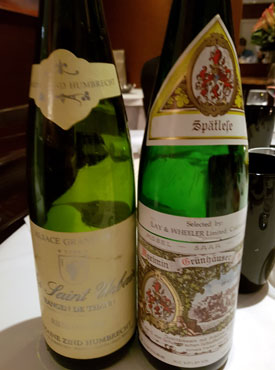
1989s from Zind-Humbrecht and Von Schubert
|
After this initial pair we moved to reds for the rest of the evening, and all wines were served in pairs with some link between the two.
Coudoulet de Beaucastel 1989
Showing a lot of garnet fade at the rim with very typical earthy, leathery, farmyard notes on the nose. The palate followed from this with fully mature leathery flavours and light, dusty tannins. This was fully mature and perhaps had seen better days, but an amazing effort for a second wine with 27 years of age!
Trevallon 1989
Deep ruby colour with a lightly garnet rim. Rich and ripe on the nose, with the classic blend of cassis from the Cabernet and lightly meaty, leathery notes from the Syrah. The aromas were layered with black fruits, cedar and spice, making this very complex. The palate showed pure blackcurrant and blackberry before giving way to undergrowth, leather and smoky, savoury spices through the mid palate. The tannins were soft, round and melted into the wine to give a smooth mouthfeel. The finish was long, with a perfect harmony between residual fruit ripeness and layer upon layer of mature complexity. An absolute knockout and without doubt one of the stars of the night.
The theme for the first pair was being from nearby regions and from Rhone varietals. While the Coudoulet was showing all its maturity, the Trevallon was a revelation and many tasters had this down as one of, if not the, wine of the night.
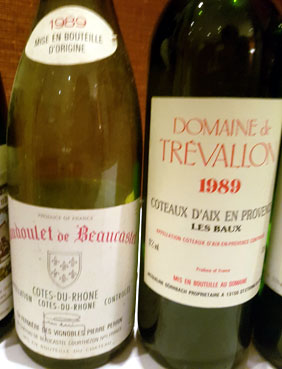
Coudoulet de Beaucastel and Trevallon 1989
|
Cantemerle 1989
This Haut-Medoc Chateau made a freak wine in 1989 that is doubtless one of the best ever made here. The bottle served was a perfect example, deep ruby in the glass with a little fade at the rim, it had sweet cassis and black cherry fruit with layers of cedar and undergrowth on the nose. The palate was plump, ripe and round with layers of black cherry fruit supported by lots of earthy, savoury cedar and spice notes. The tannins were soft and refined, making this a perfectly mature example.
Brane Cantenac 1989
Sweet cherry fruit on the nose with freshness from mature cedar, undergrowth notes. The palate was sweet with black cherry and floral with dried flowers. This plush and soft wine had no hard edges and opened out in the glass to reveal more savoury, mushroom characters on the finish. A smooth and fine example.
Though these two wines are from different appellations (Haut Medoc for Cantemerle and Margaux for Brane Cantenac), the properties are less than a kilometre apart, which was the link. To my taste the Cantemerle was the more enjoyable wine with is smooth, developed, sweet fruit but others preferred the lifted, fresh but ripe qualities of the Brane Cantenac.
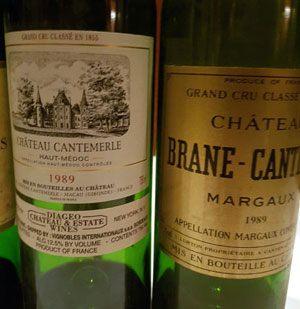
Cantemerle and Brane Cantenac 1989
|
Roc de Cambes 1989
Unfortunately not a good bottle, but previous occasions that I have had this wine show it to be a fully mature, earthy, and ripe wine with very spicy, savoury, earthy developed characters on the palate and a super silky, smooth mouthfeel. A shame that we didn’t have the opportunity to show it against it’s partner for the evening, La Fleur Petrus.
La Fleur Petrus 1989
A developed garnet rim with a ruby core, this had an intoxicating, sweet nose of caramel and black cherry. This followed on the glycerol-driven palate which left no hard edges to a super-silky mouthfeel. Sweet red and black fruits and smooth earthy undertones made this a hedonistic pleasure with real succulence and plumpness. Juicy, ripe and moreish.
The right-bank Merlot link was the intended link here but unfortunately La Fleur Petrus had to fly solo on this occasion. It showed superb Pomerol purity and sweetness.
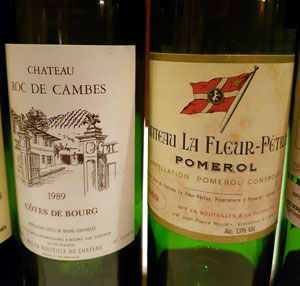
Roc de Cambes and La Fleur Petrus 1989
|
Langoa Barton 1989
A deep garnet colour with a pure blackcurrant, black cherry, cedar and black truffle nose. The palate was smooth and supple, the tannins melted into the wine and revealing savoury spice and undergrowth beneath plump black fruits. Very refined and with classic Medoc character, but with such superb ripeness and silkiness as to find superb harmony. A wonderful wine at peak maturity.
Leoville Barton 1989
A deeper, more ruby red colour than the Langoa, with a refined nose of cassis, cedar and camphor, this was more brooding and youthful than the wine next to it. The palate is intense and pure with blackcurrant fruit, showing more tannic structure which is ripe and frames the fruit beautifully, pushing the black fruit core into textured, smoky, spicy notes of leather, truffle and bramble. The finish is long, savoury and ripe, with just a little lift from balancing acidity. This is mature but has the power, length and intensity to improve yet further in the bottle over the next 5 or so years as it takes on more mushroom and savoury spice.
These two wines from the same stable showed their differing styles yet commonality superbly. The Langoa was smoother, rounder and more developed with beautifully sweet fruit at the core, where the Leoville was fresh, balanced and long with the tannin to keep improving in the bottle. They were both delicious examples of their representative Chateaux.
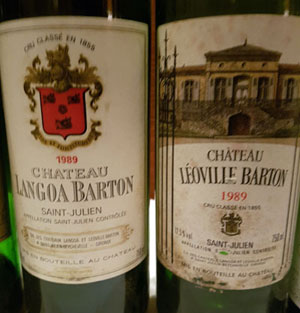
Leoville and Langoa Barton 1989
|
Opus One 1989
I was convinced this was in Bordeaux when I first put my nose in the glass. The brooding, spicy, pure black fruit aromas with hints of cedar and camphor were cool, refined and layered with no hint of opulence that you might expect from this region or producer. The palate followed, with cool but ripe cassis fruit framed by supple tannins, light savoury spice, and layer upon layer of leather, cedar and truffle. The finish was long, refined, and harmonious, with all the elements coming together with superb precision. Another standout from the evening.
Grange, Penfolds 1989
Next to the Opus this showed itself to be a real powerhouse of concentration with a deep black colour and only a slight fade, followed by a hugely intense, ripe nose. Layers of blackberry, tar, licquorice, damson and truffle honey leap out of the glass. The palate is thick, rich and round with huge concentration and power. The dense, ripe black fruit core coated the tongue with opulent damson, star anise, leather, and dark chocolate. The ripe, sappy tannins frame the mouth-coating fruit intensity through the mid palate. The flavours further flourish on the finish with heady tar, nutmeg and clove adding further layers of complexity. The long finish adds to the evidence that this wine has at least 10 years of improvement ahead of it, and quite possibly two decades or more. An absolute powerhouse.
These two wines, though both from the ‘New World’, could not have been more different in style. The Opus One really was an ode to Bordeaux with its harmonious, elegant fruit and layered, savoury complexity. The Grange showed real pride in its Australian origin by balancing a true powerhouse of ripeness, intensity and density. Both were truly superb wines, and it really came down to a stylistic, rather than qualitative, preference as to which was favoured by each taster.
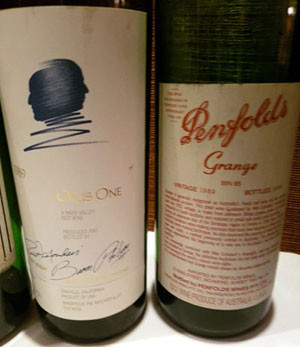
Opus One and Grange 1989
|
The overall quality of the wines from the dinner was exceptionally high with some real peaks. 1989 is clearly a vintage that is ready to drink from around the world right up to the highest levels, but the best wines, despite showing great ripeness and supple tannins, clearly have potential for further ageing in bottle. The Bordeaux all showed a wonderful ripeness and smoothness, and though they might lack the youthful concentration that the 1990s still exhibit, they have a fleshy, truffle-driven maturity that make them great wines to seek out and drink over the next 5-10 years.
I’d like to thank Stephen for setting up the dinner, Chez Bruce for superb service and food as always, and of course to our special guest for being born in such a great year!